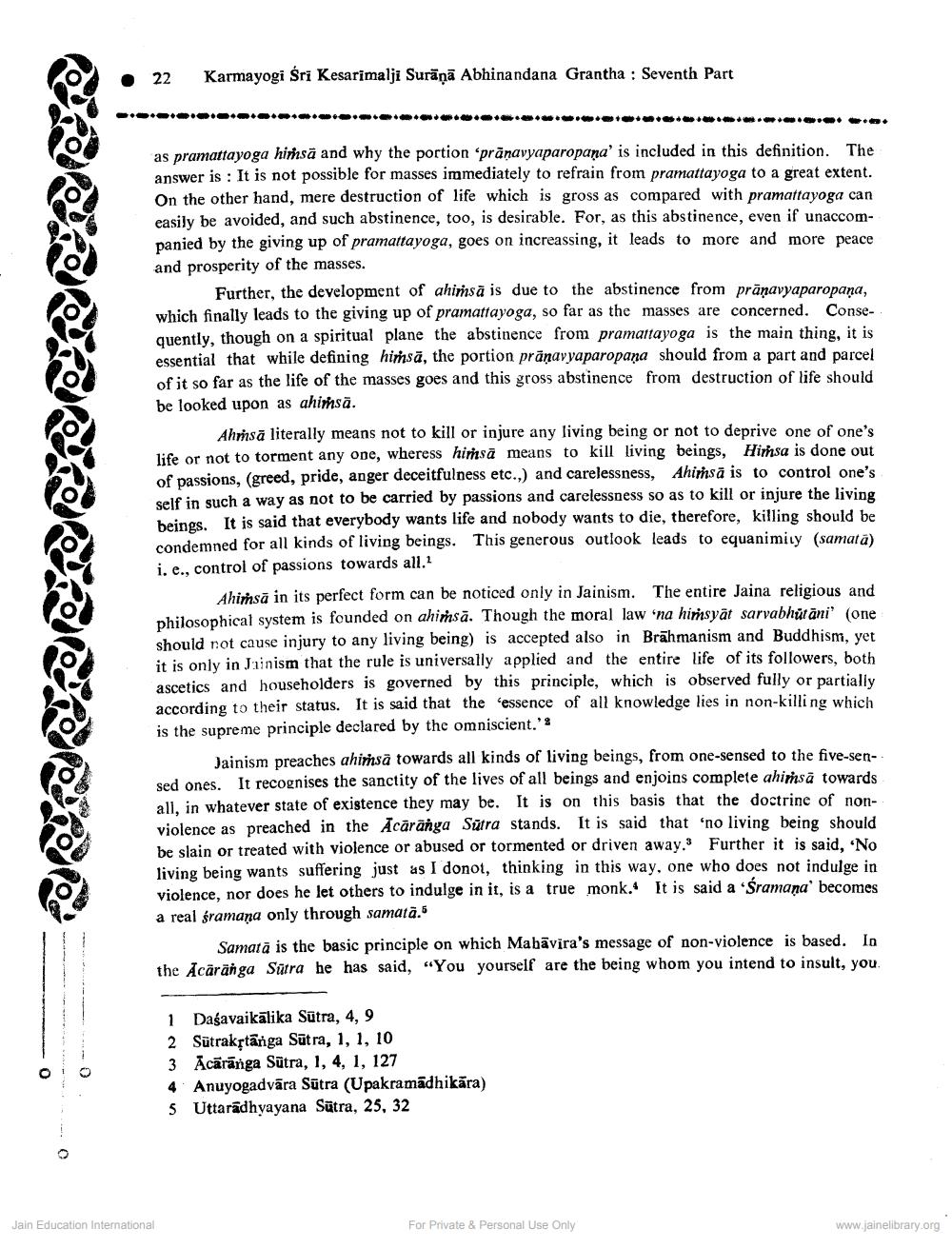________________
22
Karmayogi Sri Kesarimalji Surāņā Abhinandana Grantha : Seventh Part
as pramattayoga himsā and why the portion 'prānavyaparopana' is included in this definition. The answer is : It is not possible for masses immediately to refrain from pramattayoga to a great extent. On the other hand, mere destruction of life which is gross as compared with pramattayoga can easily be avoided, and such abstinence, too, is desirable. For, as this abstinence, even if unaccompanied by the giving up of pramattayoga, goes on increassing, it leads to more and more peace and prosperity of the masses.
Further, the development of ahirsā is due to the abstinence from prāņavyaparopana, which finally leads to the giving up of pramattayoga, so far as the masses are concerned. Consequently, though on a spiritual plane the abstinence from pramattayoga is the main thing, it is essential that while defining himsā, the portion prāņavyaparopaņa should from a part and parcel of it so far as the life of the masses goes and this gross abstinence from destruction of life should be looked upon as ahimsā.
Ahrsā literally means not to kill or injure any living being or not to deprive one of one's life or not to torment any one, wheress himsă means to kill living beings, Hirhsa is done out of passions, (greed, pride, anger deceitfulness etc.,) and carelessness, Ahirhsä is to control one's self in such a way as not to be carried by passions and carelessness so as to kill or injure the living beings. It is said that everybody wants life and nobody wants to die, therefore, killing should be condemned for all kinds of living beings. This generous outlook leads to equanimity (samatā) i. e., control of passions towards all.2
Ahińsă in its perfect form can be noticed only in Jainism. The entire Jaina religious and philosophical system is founded on ahinsa. Though the moral law 'na hirsyāt sarvabhūtāni' (one should not cause injury to any living being) is accepted also in Brāhmanism and Buddhism, yet it is only in Jainism that the rule is universally applied and the entire life of its followers, both ascetics and householders is governed by this principle, which is observed fully or partially according to their status. It is said that the essence of all knowledge lies in non-killing which is the supreme principle declared by the omniscient.'
Jainism preaches ahirnsä towards all kinds of living beings, from one-sensed to the five-sensed ones. It recognises the sanctity of the lives of all beings and enjoins complete ahiṁsā towards all, in whatever state of existence they may be. It is on this basis that the doctrine of nonviolence as preached in the Ācāranga Sūtra stands. It is said that 'no living being should be slain or treated with violence or abused or tormented or driven away. Further it is said, "No living being wants suffering just as I donot, thinking in this way, one who does not indulge in violence, nor does he let others to indulge in it, is a true monk. It is said a śramana' becomes a real śramana only through samata.
Samatā is the basic principle on which Mabāvira's message of non-violence is based. In the Acaränga Sūtra he has said, “You yourself are the being whom you intend to insult, you
1 Dagavaikālika Sutra, 4,9 2 Sütrakstânga Sūtra, 1, 1, 10 3 Ācārānga Sūtra, 1, 4, 1, 127 4 Anuyogadvāra Sūtra (Upakramādhikāra) 5 Uttaradhyayana Sutra, 25, 32
Jain Education International
For Private & Personal Use Only
www.jainelibrary.org




